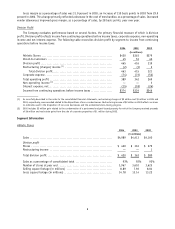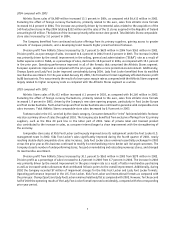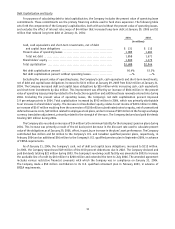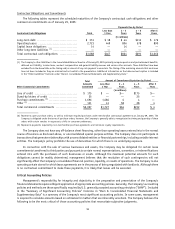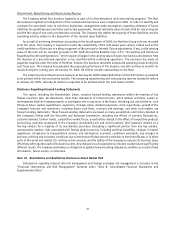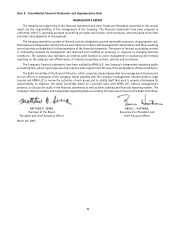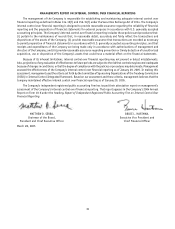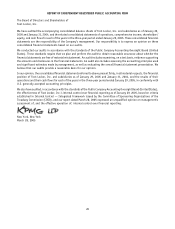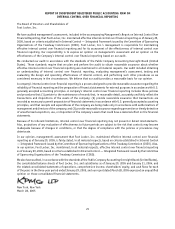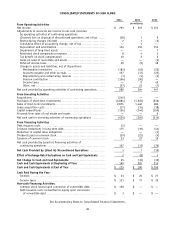Foot Locker 2004 Annual Report Download - page 32
Download and view the complete annual report
Please find page 32 of the 2004 Foot Locker annual report below. You can navigate through the pages in the report by either clicking on the pages listed below, or by using the keyword search tool below to find specific information within the annual report.
fair value of a reporting unit. The latter requires judgment and uses one or more methods to compare the reporting unit
with similar businesses, business ownership interests or securities that have been sold.
Pension and Postretirement Liabilities
The Company determines its obligations for pension and postretirement liabilities based upon assumptions related
to discount rates, expected long-term rates of return on invested plan assets, salary increases, age, mortality and health
care cost trends, among others. Management reviews all assumptions annually with its independent actuaries, taking into
consideration existing and future economic conditions and the Company’s intentions with regard to the plans.
Management believes that its estimates for 2004, as disclosed in “Item 8. Consolidated Financial Statements and
Supplementary Data,” to be reasonable. The expected long-term rate of return on invested plan assets is a component
of pension expense and the rate is based on the plans’ weighted-average target asset allocation of 64 percent equity
securities and 36 percent fixed income investments, as well as historical and future expected performance of those assets.
The target asset allocation is selected to obtain an investment return that is sufficient to cover the expected benefit
payments based on the timing of settlements and to reduce future contributions by the Company. The Company’s common
stock represented approximately 2 percent of the total pension plans’ assets at January 29, 2005. A decrease of 50 basis
points in the weighted-average expected long-term rate of return would have increased 2004 pension expense by
approximately $3 million. The actual return on plan assets in a given year may differ from the expected long-term rate
of return and the resulting gain or loss is deferred and amortized into the plans’ performance over time. An assumed
discount rate is used to measure the present value of future cash flow obligations of the plans and the interest cost
component of pension expense and postretirement income. The discount rate is selected with reference to the Aa long-
term corporate bond yield. A decrease of 50 basis points in the weighted-average discount rate would have increased the
accumulated benefit obligation as of January 29, 2005 of the pension and postretirement plans by approximately $30
million and approximately $1 million, respectively. Such a decrease would not have significantly changed 2004 pension
expense or postretirement income. There is limited risk to the Company for increases in healthcare costs related to the
postretirement plan as new retirees have assumed the full expected costs and existing retirees have assumed all increases
in such costs since the beginning of fiscal year 2001. The additional minimum liability included in shareholders’ equity
at January 29, 2005 for the pension plans represented the amount by which the accumulated benefit obligation exceeded
the fair market value of the plan assets. The Company contributed $44 million to the U.S. qualified pension plan and
contributed $6 million to the Canadian qualified pension plan in February 2004. In addition, $56 million was contributed
to the U.S. qualified pension plan in September 2004.
The Company expects to record postretirement income of approximately $11 million and pension expense of
approximately $13 million in 2005. Pension expense in 2005 reflects the Company’s expected contributions, of which
$19 million was made on February 4, 2005. These contributions have reduced 2005 estimated pension expense by
approximately $2 million.
Income Taxes
In accordance with GAAP, deferred tax assets are recognized for tax credit and net operating loss carryforwards,
reduced by a valuation allowance, which is established when it is more likely than not that some portion or all of the
deferred tax assets will not be realized. Management is required to estimate taxable income for future years by taxing
jurisdiction and to use its judgment to determine whether or not to record a valuation allowance for part or all of a deferred
tax asset. A one percent change in the Company’s overall statutory tax rate for 2004 would have resulted in a $6 million
change in the carrying value of the net deferred tax asset and a corresponding charge or credit to income tax expense
depending on whether such tax rate change was a decrease or increase.
The Company has operations in multiple taxing jurisdictions and is subject to audit in these jurisdictions. Tax audits
by their nature are often complex and can require several years to resolve. Accruals of tax contingencies require
management to make estimates and judgments with respect to the ultimate outcome of tax audits. Actual results could
vary from these estimates.
The Company expects its 2005 effective tax rate to be approximately 36.5 percent.
16


